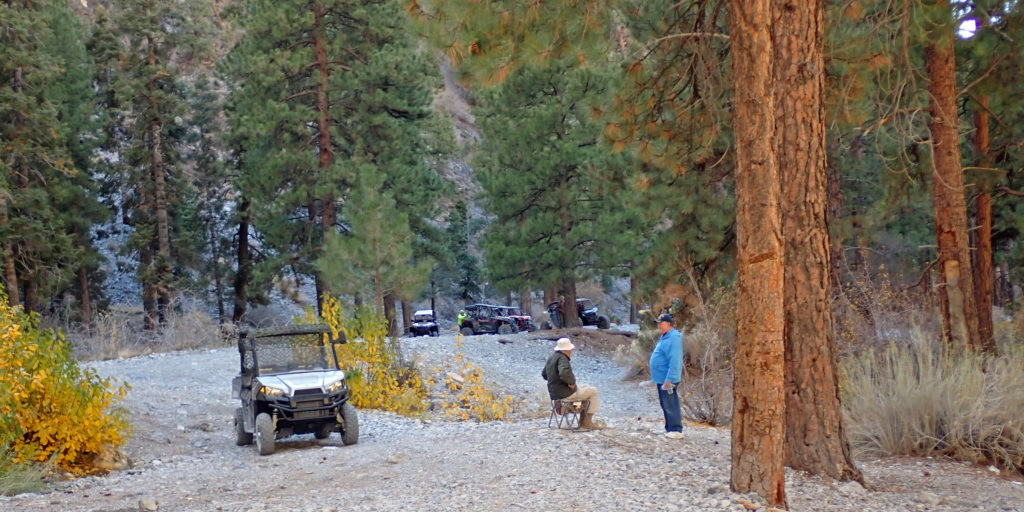
In the 1970s I developed an interest in U.S. Geological Survey topographic maps (i.e., topo maps). Hunting and fishing with my brother Neal often involved these topo maps. While the first satellite global positioning system (GPS) had been created by the US military, civilian use did not materialize until 1993. Civilian access to the Internet also occurred around 1993, but cell phone GPS was not available until 1999. Until civilian GPS became available, topo maps were the best way to explore the outdoors.
Orienteering can be described as the art of using a map and compass to navigate from one known location to another known location. Europeans not only used orienteering for basic countryside travel, but they also originated the sport of orienteering in the early 1900s. In an orienteering contest, the goal is to navigate through a set of specified way-points until the final destination, often miles away, is reached as quickly as possible. For outdoorsmen, navigating to geographic locations for hunting, fishing, or simply exploring is a wonderful way to give purpose and, dare I say, direction to your adventure (similar to what Geocaching and Letterboxing do for others who love exploring the outdoors).
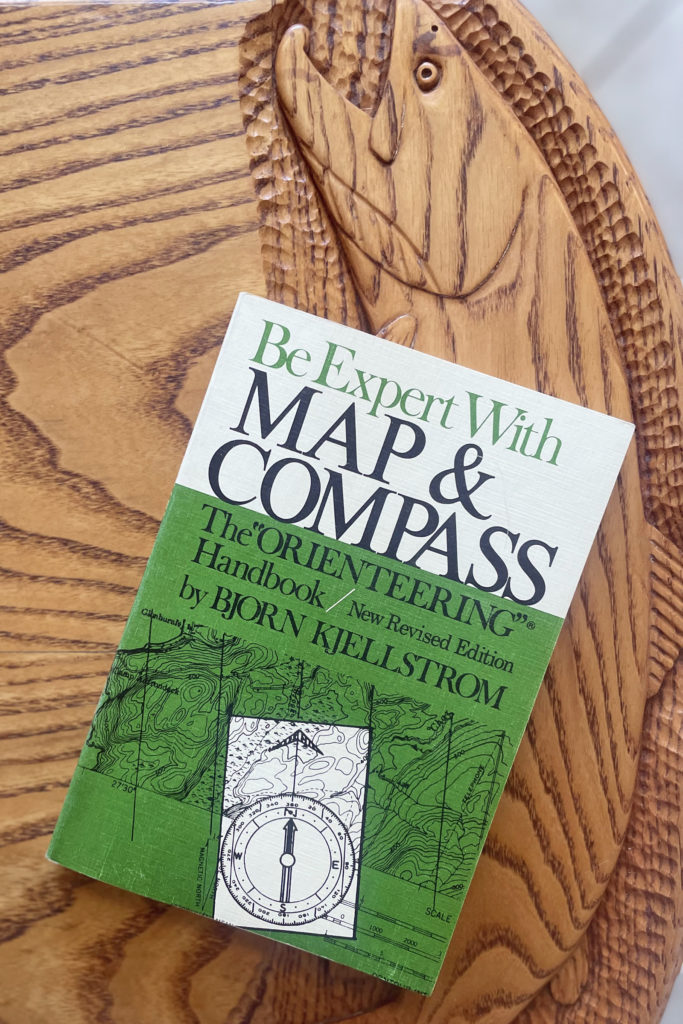
Thanks to USGS topo maps I discovered Cold Creek (as of this writing I have 34 blog posts that relate to Cold Creek), explored and fished the alpine lakes in the Ruby Mountains (four posts), and laid down a new backpack trail up Beaver Dam Creek (4 posts) all the way to Split Pine Hollow just 300 yards west of the Utah/Nevada boundary. I love maps of all sorts and hold fond sentiment for USGS topo maps, but I have reached the 21st century by subscribing to Gaia GPS on my iPhone. I was impressed by Gaia’s performance when I explored the Mary’s River drainage south of the Jarbidge Wilderness Area, although it was not entirely necessary. To read more about Gaia click on this Elko County blogpost and scroll down near the bottom looking for the subheading Gaia GPS App.
The only business that sold USGS topo maps in Las Vegas when I started orienteering was Mercury Blue Print & Supply on South Main Street. It was purely coincidental that it was owned and operated by my future father-in-law. You could order specialty topos directly from the USGS, but Mercury Blue had the largest selection of maps, by far, anywhere in Clark County. I would like to say I often shopped at Mercury Blue just to see the lovely young lady who would become my wife, but the truth is she did not regularly work in the shop.
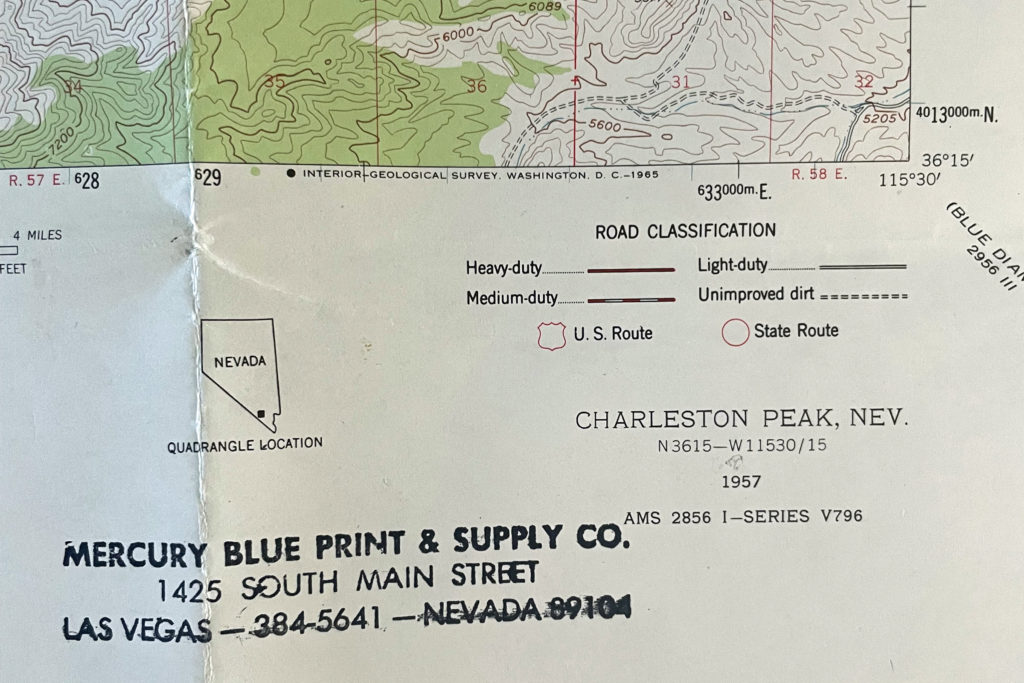
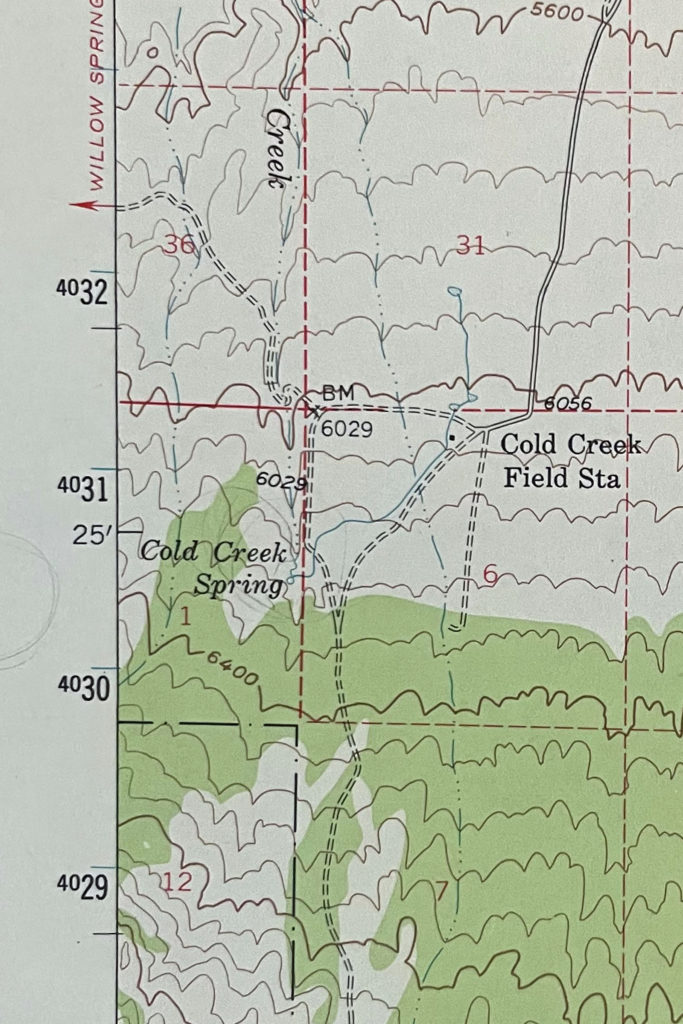
I used topo maps to explore quite a bit of the Spring Mountains (which includes Red Rock Canyon and Mount Potosi), so named for its numerous springs. The range also has at least eight small creeks such as Cold Creek, Willow Creek, Deer Creek, Pine Creek, Oak Creek, First Creek, Trout Creek, and Carpenter Creek. I have visited the water of all these creeks except Deer Creek (which might be intermittent) and Carpenter Creek. Today, on Veterans Day, I finally added Carpenter Creek to my list.
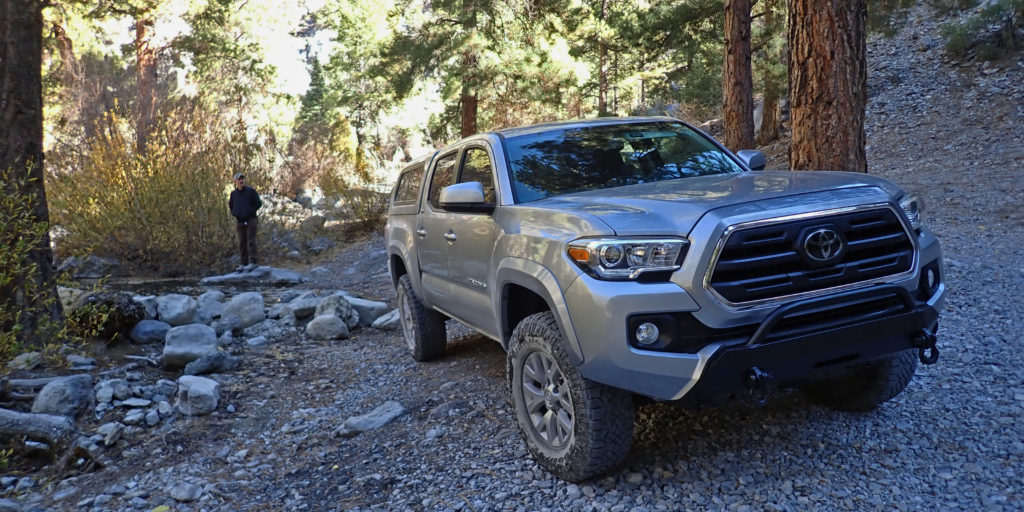
I admit to another motive besides four wheeling up Carpenter Creek. In the 1950s, the Nevada Department of Fish and Game (now the Department of Wildlife) planted Lahontan cutthroat trout (i.e., LCT) in Carpenter Canyon’s Peak Spring. (Peak Spring is now known as Carpenter Creek.) I imagine that Carpenter Creek was chosen because it is a perennial stream in a comparatively dry climate that is remote from Las Vegas. Most notably, it is not in the Great Basin, LCT’s native habitat, but rather in the Mojave Desert’s Spring Mountains.
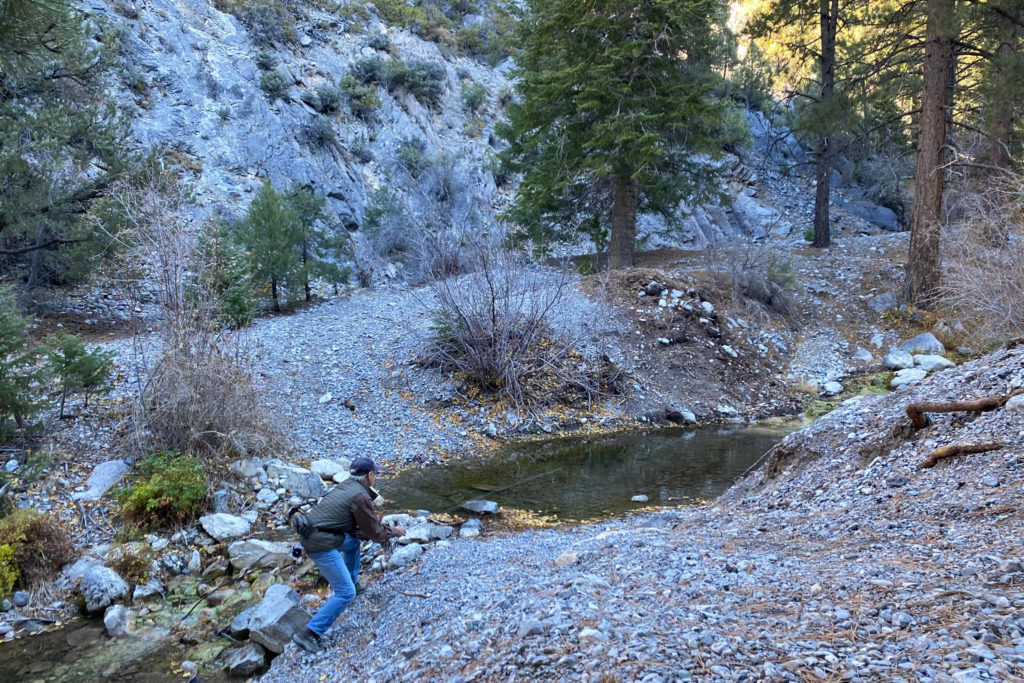
Their “experiment” seems to have worked as the LCT have carved out an existence in this tiny creek, free of competition from the more ubiquitous brown and rainbow trout that tend to aggressively dominate the LCT, not to mention their hybridization with rainbow trout that depletes their gene pool. The LCT was listed as endangered in October 1970 under the Endangered Species Protection Act of 1969. Subsequently, in July 1975, the LCT was reclassified as threatened under the Endangered Species Act of 1973. If you would like to know more about the LCT, check out The Western Native Trout Initiative website.
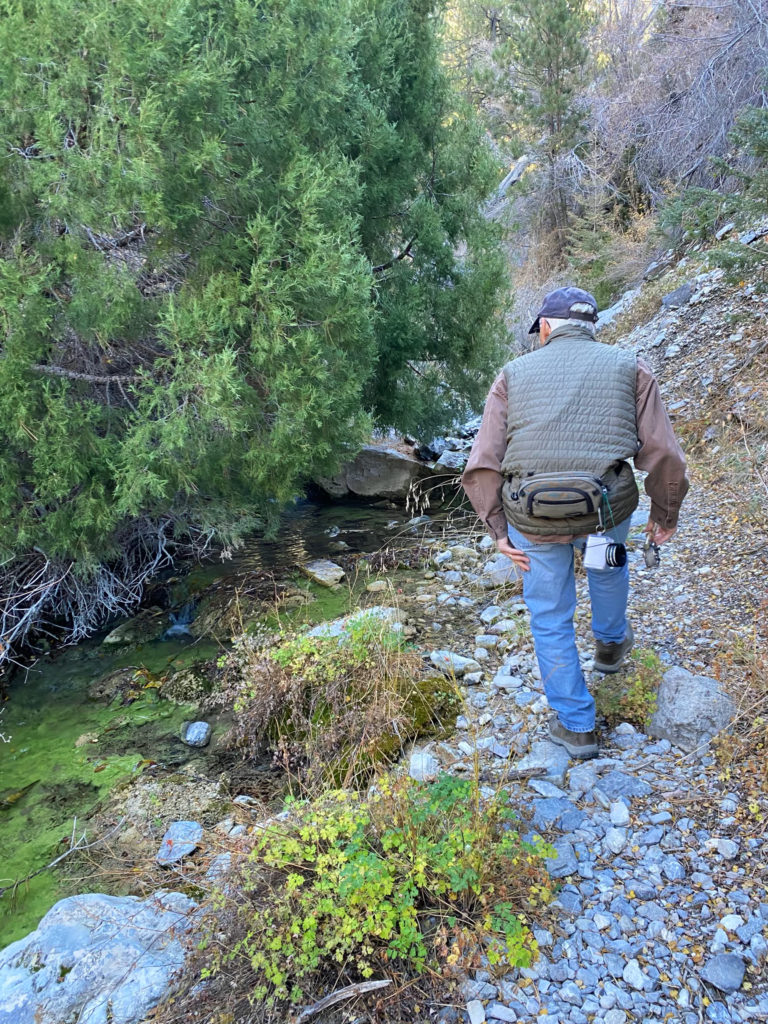
Based on what I thought I knew about this creek and its small population of LCT, I decided to fish as much of it as I could with my favorite 7 ½-foot fly rod, floating 4-weight line, and a size 16 elk hair caddis dry fly (“dry flies” float on the water’s surface). I say “as much of it as I could” because I knew Brian had to be home by 3:00pm to prep for work (which meant we had to start home by 1:00pm), and I was concerned that my aging body would have difficulty bushwhacking and scrambling up the narrow canyon, not to mention the bending, crouching, and kneeling necessary to avoid detection by the trout who rush into their hiding spots whenever they see unnatural movement above their shallow water-world. My son Brian’s presence eased any family concerns about me in case of any mishaps or incidents.
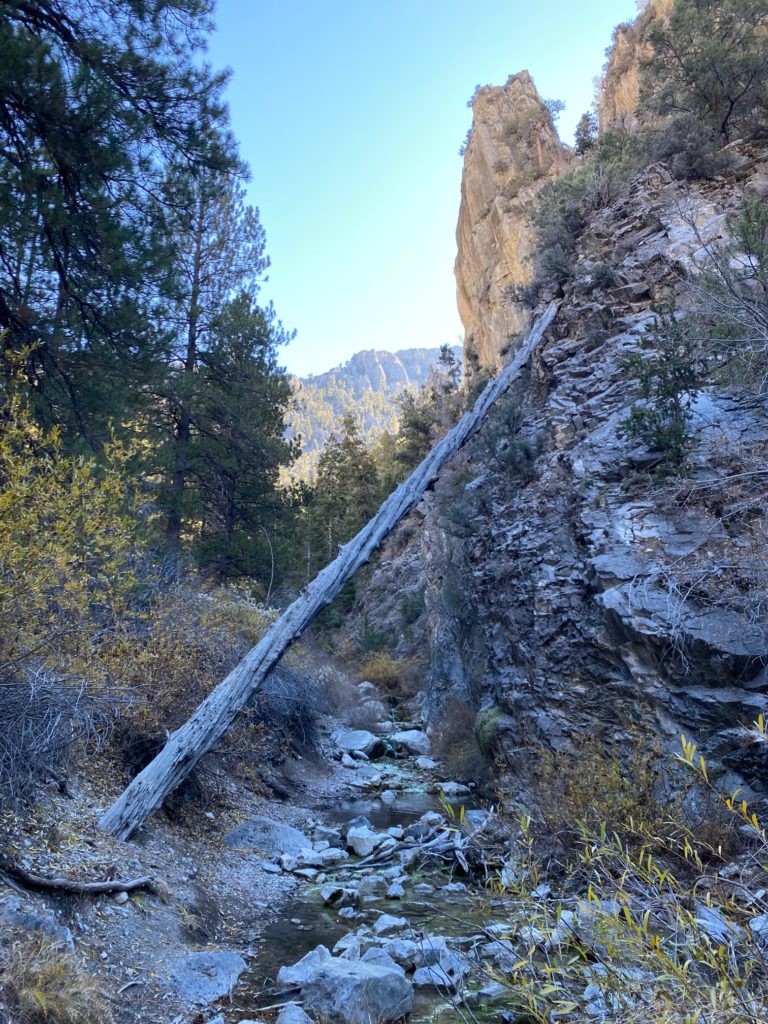
I did indeed teeter a few times while stepping on boulders to cross back and forth, but I was surprised by my ability to stalk these trout. Although small, I was pleased to sight so many trout in a creek so tiny (maybe about ten in total). In these type of creeks, not all pools are fishable without frightening the the fish, so I only attempted very short casts on four pools I thought contained trout. In two of those four pools I was fortunate to hook an LCT.
The first trout hooked was small, maybe seven inches, but my dry fly dislodged within ten seconds. The second LCT was substantially larger, a good ten inches. It had a couple seven-inchers finning in the water near its flanks. All three were actively feeding at the tail end of a large, flat, pale boulder that acted like a plate which softened the water that was dropping into the head of the plunge pool. The trout were easily identified against the pale boulder from my position on the bank fifteen feet away from the left side of the creek. I recall it was my second cast that fooled the larger trout, and it was a little raucous in the water for fifteen seconds or so. I was feeling pretty confident that I would bring the trout to hand for a quick photo before it was released, but it had other plans. It sulked in a small channel on my side of the pale boulder, so I tried one more dapping-like cast but the LCT immediately ducked underneath the protection of another rock.
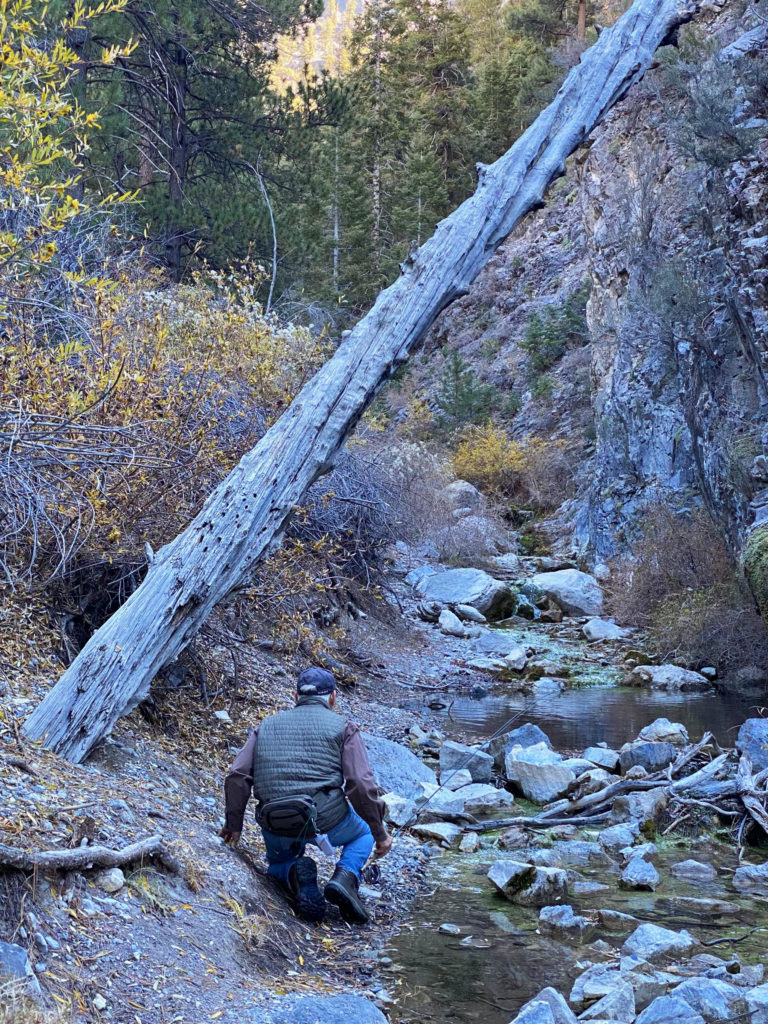

I was not upset by its early escape. While I would have treasured a photo of it, I was more happy that I had fooled it and that its quick get away ensured minimal stress from its encounter with the caddis dry fly. It is the stalking, casting, and hooking that produce the most pleasure for me; the playing and releasing of cherished trout always comes with a sense of anxiety for me, but mostly for the trout. For those of you interested in catch and release (vitally necessary for the survival of these LCT trout in Carpenter Creek), here are some important basic steps you should take according to the Front Range Anglers website:
- Use single barbless hooks
- Keep the fish in the water as much as possible.
- Trout have a protective slime. Protect that slime by keeping hands and net wet.
- Use a rubber net. Large mesh allows for quicker removal of hooks.
- Avoid unnecessarily long landing battles.
- Trout gills are particularly susceptible to poison, infection, and puncture. Never allow anything, especially fingers inside the gill plate.
- If the hook cannot be retrieved easily, cut the line.
- Trout are lot more fragile than warm water or salt-water fish.
- Large trout are less resilient than small trout, be extra careful with them.
- Adverse conditions such as water temperature greater than 65 degrees, require extra care in handling fish. If it’s above 70 degrees, you probably shouldn’t be fishing and many waters will close during this condition.
Although I have known about Carpenter Creek from the topo map I purchased from Mercury Blue when I was in college, for unknown reasons it has taken me about 45 years to explore it. For the last ten years or so I have read stories and seen photos of other angler success on Carpenter Creek. Several years ago my friend, Chan, shared his personal experience with the LCT of Carpenter Creek. Chan’s account of the angling resolved me to explore its waters for myself. I am not one for regrets, but I can say that had I driven my 1979 Toyota Hi-Lux 4×4 up there in the 1980s I believe I would have several trips to the creek already banked in my memory.
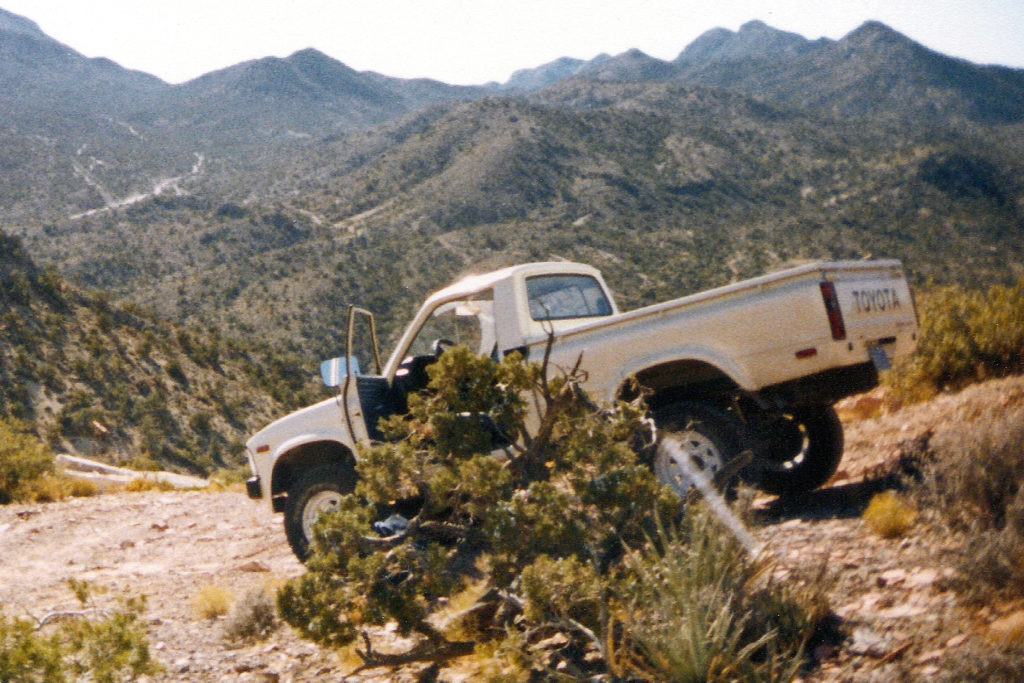
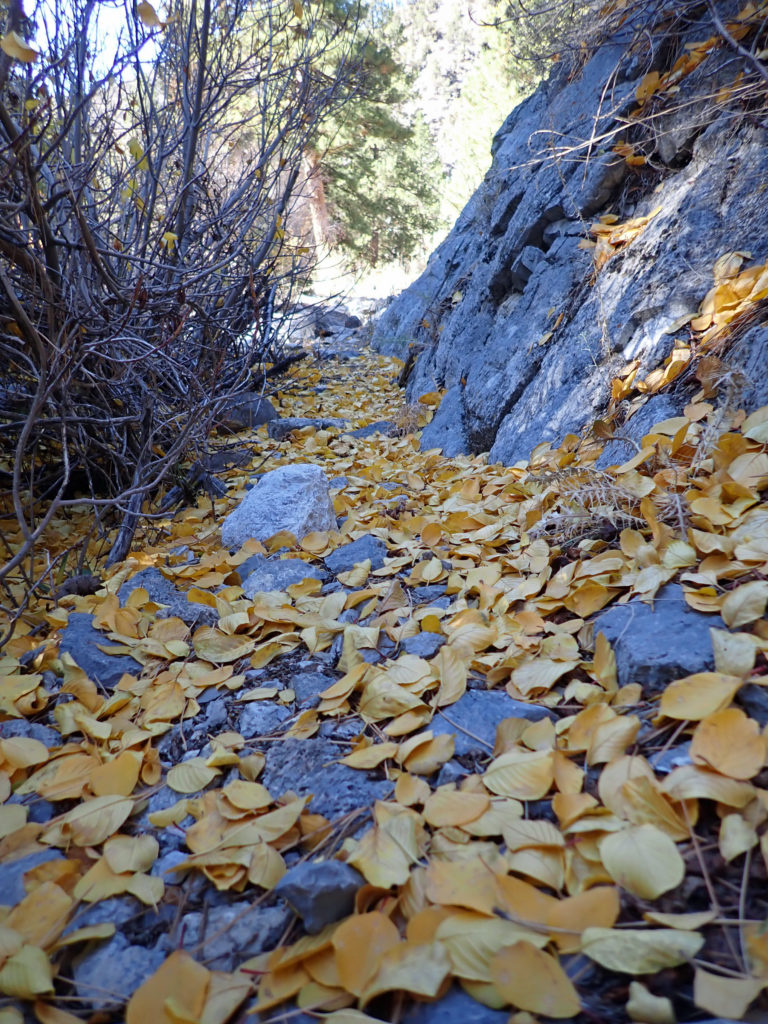
Maps are very useful tools for those wishing to discover and visit destinations that intrigue their sense of adventure. Serious trout anglers pursue the “blue lines” on the topo maps for the jewels of the mountain streams. If you know where you want to go, maps will get you there if you understand their symbols and nomenclature, and more importantly if you carefully follow their instruction. Travelers and orienteers still make mistakes and fall off the trail, but reapplication of the tools will soon get you back on course.
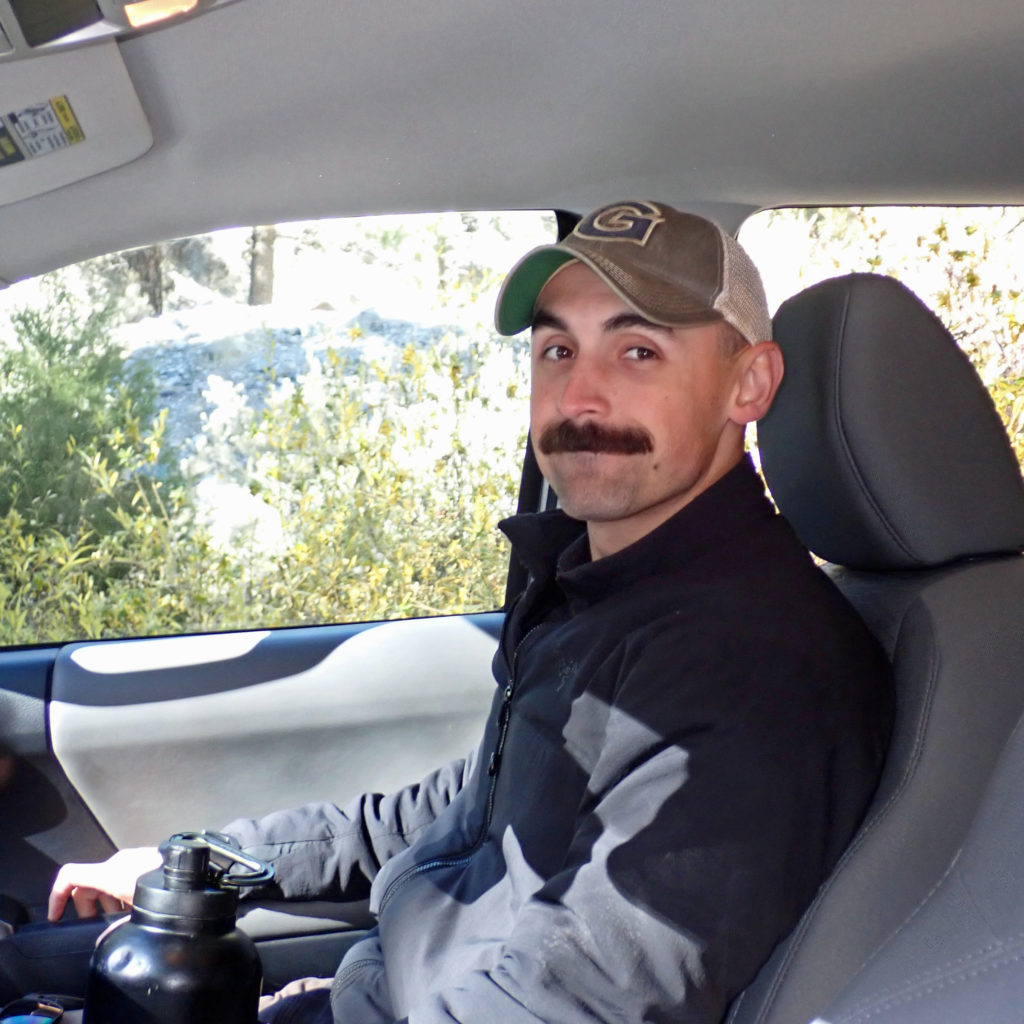
I recently ran across an article on the Internet titled, “The Bible is Our Roadmap for Life.” The author used two analogies regarding the use of maps:
When the United States was in a race to put men in space and on the moon, imagine an astronaut coming into the program and saying, “I know the way to the moon. It’s straight up. I don’t need a map. I don’t need any training.”
Imagine a Seal Team that has just received orders to go into the jungle to rescue some Americans that have been kidnapped by a terrorist organization. As the leader of the operation is about to share the plan and lays a map out for the team to study, one of the members of the team grabs the map and wads it up and says, “We don’t need a map or a plan. I know the way. Just follow me.”
Men especially have a reputation for avoiding travel maps and assembly instructions. (I am certain I am one of them who falls into this category too often.) We either feel more manly because we figured it out by ourselves, or we think the corollary opinion will be we are weak minded and in need of help. This is a form of stinkin’ thinkin’ because both are untrue. I have used a map of one form or another to get to every fishing or hiking travel adventure I ever had. I have never wandered aimlessly in my truck or on a hike simply hoping I would run into something I wanted to find. At the minimum this approach would be illogical, and at worst it would be insane. For those interested, here are a few verses that touch on the Bible as a map or instruction for salvation:
All Scripture is breathed out by God and profitable for teaching, for reproof, for correction, and for training in righteousness, that the man of God may be complete, equipped for every good work.
2 Timothy 3:16-17 (the Bible is the inspired word of God)
Keep hold of instruction; do not let go;
Proverbs 4:13 (the Father’s wise instruction)
guard her, for she is your life.
Incline your ear, and hear the words of the wise,
Proverbs 22:17-21 (words of the Wise)
and apply your heart to my knowledge,
for it will be pleasant if you keep them within you,
if all of them are ready on your lips.
That your trust may be in the Lord,
I have made them known to you today, even to you.
Have I not written for you thirty sayings
of counsel and knowledge,
to make you know what is right and true,
that you may give a true answer to those who sent you?
I passed by the field of a sluggard,
Proverbs 24:30-34 (more words of the Wise)
by the vineyard of a man lacking sense,
and behold, it was all overgrown with thorns;
the ground was covered with nettles,
and its stone wall was broken down.
Then I saw and considered it;
I looked and received instruction.
A little sleep, a little slumber,
a little folding of the hands to rest,
and poverty will come upon you like a robber,
and want like an armed man.
and you say, “How I hated discipline,
Proverbs 5:12-13 (a warning against sin)
and my heart despised reproof!
I did not listen to the voice of my teachers
or incline my ear to my instructors.”
For me, the Bible describes the reason for my life and its purpose. It reveals God to me in a way that I can understand His nature and will. It is not merely a moral compass, but a revelation of the Lord in a way I can humanly comprehend (Jesus said, “I am the way, and the truth, and the life. No one comes to the Father except through me. If you had known me, you would have known my Father also. From now on you do know Him and have seen Him”-John 14:6-7). I am free to ignore this revelation, its path to eternal life in His presence, or to follow only those paths or instructions that I like, but I know those choices will get me lost eventually. Yes, I do get lost more often than I like, but I believe the trail becomes clearer to me every day.
May your journey be a blessing to you and yours.
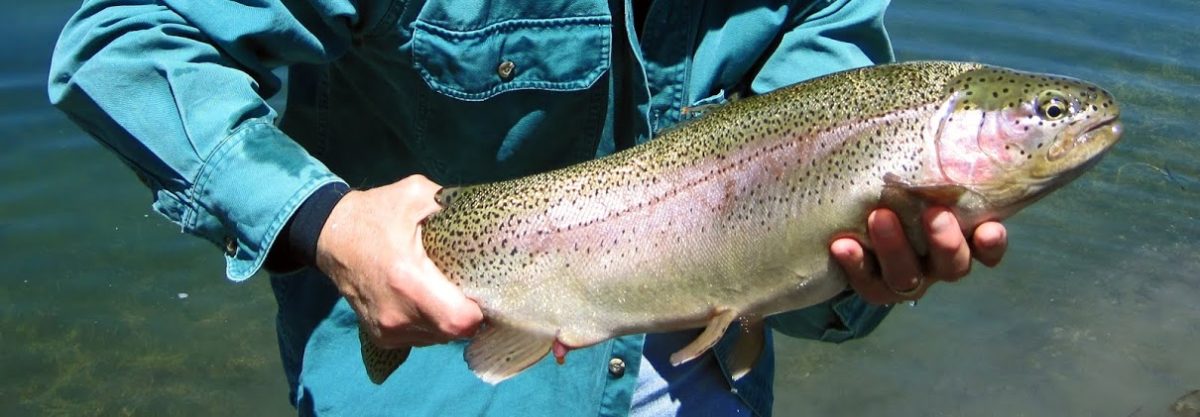
Hey hey Mark. Thanks for the shout out. I remember our conversation very well. I’m glad to hear there are still little guys in there. I was afraid after the fire a few years back that it may have ended the habitat for the poor little guys there. Great post. Tight lines!
Chan –
From the Pahrump view the burn area on the southwest side of Charleston is massive, but it didn’t seem to travel over to Carpenter Canyon.
I was thinking of you all while I was fishing. I should have reached out to see if you were willing to be my fishing guide up there.
My best to you and the family.
Mark, loved this blog – instructional, beautiful photos, and fun!
Thank you, Judy. I was telling my brother-in-law about my stash of these topo maps that I often spread out and review in my hands. It’s like holding a book in my hands in which I’ve written notes and comments from years gone by. Maybe some observations on my life. I grudgingly use technology because it is convenient, but generations to come will not know the comfort of holding a book in their hands. I suppose blogging (my weapon of choice) and eBook publishing enables anyone to write about their lives without the cost of publishing on paper, but I so enjoy reading a paper, book, or magazine in my hands while in a comfy reading chair.
May the Lord bless you and keep you!
Hey Mark, been following your blog for almost 10 years now. I discover Cold Creek because of you and that’s where I started fishing and landed my first trout – a rainbow. Since then my love for fishing has grown and discover new fishable waters from your reading including – mammoth creek, Kirch, Panguitch, Cave Lake, Eagle Valley, Mary’s River and Angel Lake. I also got to experience Carpenter Creek last year and landed a few LCT. Thank you for spreading the love of fishing with the likes of me. Keep up the great Writing and happy fishing.
Alberto –
How wonderful to hear from you. I am forever grateful you took the time to share your appreciation for trout angling, and the role this blog had in your exploration and enjoyment of the pastime I cherish the most. It is gratifying to know that folks outside my “friends and family” circle enjoy the blog and find it useful as well.
Trout are one of the most beautiful sport fish, but their existence depends upon clean, cold streams for their reproductive success in the wild (i.e., natural reproduction as opposed to the “petri dish” variety that most fish hatcheries employ that eventually leads to confused and weakened gene pools of the unique trout species), especially necessary for threatened species like Lahontan cutthroat trout (found in Nevada streams like Mary’s River and Carpenter Creek) and bull trout (found in Nevada’s Jarbidge River) as well as species found in other states such as the cutthroat trout of the northwest and California’s golden trout and steelhead trout (anadromous form of west coast rainbows). Anglers like us must continue to support laws, regulations, rules, and best practices that ensures not just their survival, but their vigorous thriving.
I hope you continue your pursuit of the inspirational places that our beloved trout inhabit, and that you pass on your good sportsmanship to the others whose paths you cross over the years. More importantly, I pray my expression of faith in this blog helps you find your highest purpose in life.
Tight lines my friend!
– Mark
Fisherdad,
I haven’t visited your site in some time and am just now seeing this post from Nov 🙁 . Those are beautiful pictures and I’m glad to hear there are LCT in the creek. I went there a few times about six – seven years ago. At that time the water was so low I wasn’t sure the population could continue and I only saw one trout in my multiple trips there. Maybe I’ll try to get up there again…
Your pictures and narrative of the topographical maps was also very nice. I got rid of my old topo maps years ago but, like almost everyone else, still miss something about them. In addition to their “character” and “feel” one huge advantage they offer over newer digital options is their size. The few square inches on a phone screen or even a tablet requires the user to constantly zoom in and out as well as pan around constantly. It’s almost a luxury when I can hold a real map and look over a large area in full detail without any hassle 🙂
Thanks for posting and keep up the good work.
Ron,
Thanks for the late comment. You are so right about large topo maps vs our iPhones or even iPads. And the ease and satisfaction of writing notes and observations right on the paper map… can’t touch that with a mobile device. I was recently listening to a TED Talk with Elan Musk. He’s working on an AI robot (in theory because he needs that level of AI to autopilot driverless Teslas). All I could think was, who the heck wants an AI robot as a maid, butler, caregiver, or companion. Technology… egads!
Yes, visit Carpenter Canyon again. It’s worth it to hold a wild LCT in your net even if for but a few seconds.
May He bless you on your future travels!
Mark
Hey Mark, I enjoy your blogs and have been following you for years now. I know your son from work! Have ran many calls with him!
Anthony –
Wow, aren’t you amazed at how small the world is? It’s a privilege to know that besides sharing our love for angling trout with a fly, you also work with my “number four” son, keeping our community safe. Thank you so much for that.
I note that you first commented on this blog on November 2015. I have visited, and commented, on your Fishing the West blog a couple of times. You have done very well on those Bonneville cutthroats… as your fantastic photos document.
So, are you going to give the LCT in Carpenter Creek a try? If you do, please tell me how it went.
All the best to you!
– Mark
Mark, I have fished Carpenter for many years! How can I share some pictures with you?
Check your hotmail inbox…
I have many trips to share with you I have done! Your blog has a big influence on it!! It is indeed a small world!
Mark, I came across your blog today as I researched Carpenter Creek on the web and plan a trip up the mountain in the cooler months. I live at the south end of Pahrump very close to the Carpenter Canyon Trail. I’m also a Christ Follower. Do you by chance attend Hope Church in Las Vegas off of Cactus Ave? I’ve heard that there are a few older gentleman that are part of the church that love to fly fish but I haven’t had the pleasure of meeting them. In this part of the country it’s hard to find fellow fly anglers, and even harder to find ones that share a submission to Christ. I’d love to connect sometime and have a conversation about fishing, etc.
Austin –
I’m so pleased to hear from you. I am currently laid-up from some significant vascular surgery. The Lord willing I can wet a fly this fall.
I attend Valley Vegas Church near Sahara Avenue and Arville Street. Prior to that Canyon Ridge Christian Church, and prior to that Christ the King Catholic Church. A while ago I had a comment posted from a pastor of a local church, perhaps from the one you mentioned. I’ll see if I can locate that post/comment.
May the Lord bless you and keep you, Austin
Glad to hear that you are recovering and your surgery went well. May this allow for continued health and ability to cast a line for years to come.
I’ve enjoyed reading your different blogs and getting to know you through your insights, experiences, shared verses and pictures. I look forward to potentially meeting in the near future and tapping into your amassed Fly Fishing Wisdom.
August 13th I am embarking on an adventure down the Green River in Utah. 8 hour drift boat float. I’m told that there is an estimated 12,000-15,000 fish per mile of river. German Brown’s average 23 inches. That will be my first time fly fishing from a drift boat. I will share pictures if I am lucky enough to hook one.
Thank you for the well-wishes. I turned down an opportunity to float the Green with my fishing buddy several years ago. I regret that now. I’d love to hear of your experience.
Mark,
I’d like to chat with you some time and possibly meet or fish together once you’ve fully recovered.
702 503 0788
Austin, see this post. Rick from North Valley Fellowship posted a comment regarding fly angling pastors.
https://www.fisherdad.com/2013/03/08/cold-creek-contrarian/
Hello,
I’m disabled and I just wanna see the waterfall. Is hiking the only way to get there?
Hello Bernadette!
Yes, once you get to the terminal end of the Jeep track that requires a good clearance 4×4, you will still need to hike a little bit. There are no ADA accessible trails up there.
My best to you on your adventures.
I have a friend whose grandson was last seen Saturday in Carpenter Canyon, Clark County, Humboldt-Toiyabe National Forest and was reaching to see if you know of any search and rescue groups in the area that we could reach out to. I understand that the terrain is somewhat difficult to navigate. We are not getting allot of support for Sherrif department or Las Vegas police and are desperate to try and find him. Thanks
Joan, Try the Las Vegas Metropolitan Police Department (LVMPD) Search and Rescue (SAR) Team. You can contact them through calling (702) 828-3111.
Prayers for your grandson and family for his safe return…
I just realized that number wasn’t the SAR direct number.
Here is their website: https://lvmpdsar.org/
Try Red Rock SAR : https://redrocksar.org/
Their Emergency Hotline is 702-758-4727
thank you
Fisherdad,
Your blog inspired me to adventure up to Carpenter Canyon Creek in April (while in Las Vegas for a banking/payments conference). I was able to rent a Ram 1500 in Vegas and I set out early the day before the conference was to begin; full of optimism.
After about 6 miles of Carpenter Canyon Road I realized that the two wheel drive Ram was not the best vehicle for the rutted out switchbacks going up the mountain. I was alone, without cell reception, and burdened by the promise I had made to my wife that I wouldn’t “try anything stupid.” Reluctantly, I backed down the trail a ways until I was able to find somewhere to turn the rig around and head back down the mountain, thoroughly disappointed and defeated.
On my way down the mountain I even saw a 4 seater buggy heading up the trail and if he’d had a seat available I would have stopped him and begged for a ride to the stream.
Well, April is coming and I have booked my travel for the conference and I’m determined to get to that stream this year. Do you know of any guides, or folks that’ll rent an ATV to me for the day just so I can get up there? I’ve spent the last 8 months in agony over my failure to make it up there last year. I simply cannot get it out of my head. I’ve actually added it to my bucket-list (not joking). I simply have to get up there and catch a LCT on my 2 wt glass rod with a barbless dry fly.
Do you know if there are places to camp along the way? Because I’m tempted to try and get there by foot.
Any help, guidance, assistance, or encouragement would be greatly appreciated.
Thanks for sparking this obsession.
Adam –
There are several ATV rental/tours companies in Pahrump, NV. A search might produce one that can get you up to Carpenter Creek. I am not an ATV enthusiast, but there are many of them in the town of Pahrump.
Best of luck on your quest
– Mark
Thanks, Mark. I haven’t had any luck finding one yet, but I’ll keep searching. Thanks for the quick response. I hope you’re doing well.
Adam, try this one: https://www.barrysutvadventures.com/private-guided-tours.html
Barry’s UTV Adventures (818-473-0778 or email to barry@barrysutvadventures.com) website indicates he gives tours of Carpenter Canyon.